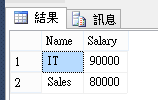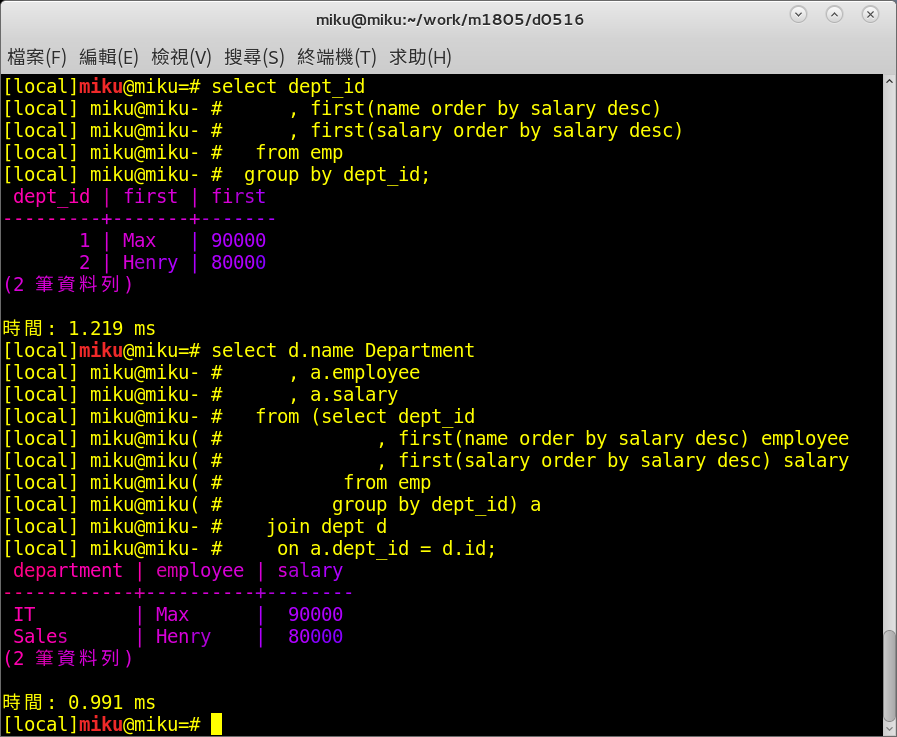HI,這是演算法挑戰挑戰的第二篇,我這個人習慣有求必應,所以這篇就來解解SQL的題目吧!
題目名稱:Department Highest Salary
難易度:中
題目內容:從Employee和Department兩張資料表中查詢出各部門領最高薪水的人及金額。
例如:Employee表內容:
| Id | Name | Salary | DepartmentId |
|---|---|---|---|
| 1 | Joe | 70000 | 1 |
| 2 | Henry | 80000 | 2 |
| 3 | Sam | 60000 | 2 |
| 4 | Max | 90000 | 1 |
Department表內容: |
|||
| Id | Name | ||
| ------------- | ------------- | ||
| 1 | IT | ||
| 2 | Sales | ||
| 查詢結果: | |||
| Department | Employee | Salary | |
| ------------- | ------------- | ------------- | |
| IT | Max | 90000 | |
| Sales | Henry | 80000 | |
| 那以下開始動工: |
/*SELECT資料欄位*/
SELECT d.Name AS Department ,e.Name Employee ,s.salary
/*以部門為主檔*/
FROM Department d
LEFT JOIN
/*找出各部門的最高薪水*/
(SELECT MAX(Salary) Salary ,DepartmentId
FROM Employee
GROUP BY DepartmentId) s
/*用部門編號取得部門名稱*/
ON s.DepartmentId = d.Id
/*連結員工資料表*/
LEFT JOIN Employee e
/*用在哪個部門,以及該最高薪水找出對應的人名*/
ON e.DepartmentId = s.DepartmentId AND e.Salary=s.Salary
/*如果有該部門但沒有人員會回傳NULL,所以這時候把他過濾掉*/
WHERE s.salary IS NOT NULL
嘛...雖然我是用這個方式串出來了,但是其實我在下SQL的時候除非跑得特別慢,不然我都不會去注意到效能的問題,也沒有認真研究過怎麼處理資料會比較好,只想著最後出現是我要的就好,如果出現不了再從程式下手![]() ,所以我在SQL解題的時候通常都會硬湊,如果看到我的解題方式,有哪裡可以改進的,再麻煩各位大大留言告訴我,我會在今後的寫法一一嘗試的
,所以我在SQL解題的時候通常都會硬湊,如果看到我的解題方式,有哪裡可以改進的,再麻煩各位大大留言告訴我,我會在今後的寫法一一嘗試的![]()
另外如果寫法有誤或有什麼問題,也都可以告訴我,我在盡速修正,謝謝大家!

晚上試作了一下,
我的解法也跟你一樣...
哈哈哈,我們都一樣,英雄所見略同![]()
我下SQL時也不會特別注意效能問題,原因是因為專案型的案子業務接進來時,DB都已經不知道經過幾手了,資料本身有些就很悲劇了,能撈出PM要的資料就"阿彌陀佛"了!所以公司才要導入Spark來整理來自各廠DB的資料!
哈哈,真的欸!
其實只要資料不要跑得很久,我都不會特別去注意到哪種寫法比較好,而且現在有分頁語法,就算效能差也不會一次查很多筆資料,除非是報表![]()
哈哈哈,我也一樣!!![]()
DECLARE @Employee TABLE
(
Id INT,
Name NVARCHAR(50),
Salary INT,
DepartmentId INT
);
DECLARE @Department TABLE
(
Id INT,
Name NVARCHAR(50)
);
INSERT INTO @Employee
(Id, Name, Salary, DepartmentId)
VALUES
(1, N'Joe', 70000, 1),
(2, N'Henry', 80000, 2),
(3, N'Sam', 60000, 2),
(4, N'Max', 90000, 1)
INSERT INTO @Department
(Id, Name)
VALUES
(1, N'IT'),
(2, N'Sales')
SELECT C.Name,
A.Name,
A.Salary
FROM @Employee AS A
LEFT JOIN (
SELECT A.DepartmentId,
MAX(A.Salary) AS Salary
FROM @Employee AS A
GROUP BY A.DepartmentId
) AS B ON B.DepartmentId=A.DepartmentId AND B.Salary=A.Salary
LEFT JOIN @Department AS C ON C.Id=A.DepartmentId
WHERE B.Salary IS NOT NULL
ORDER BY A.DepartmentId
一種工程師的默契,只是主表反過來了,哈哈哈XD
下篇的這個系列我去翻翻看有沒有我覺得很酷的解法分享好了![]()
恩~~我也玩玩了@@~
declare @Employee table(
Id int
,Name nvarchar(50)
,Salary int
,DepartmentId int
)
insert into @Employee
values(1, N'Joe', 70000, 1),(2, N'Henry', 80000, 2),(3, N'Sam', 60000, 2),(4, N'Max', 90000, 1)
declare @Department table(
Id int
,Name nvarchar(50)
)
insert into @Department
values(1, N'IT'),(2, N'Sales')
select Name,Salary
from (
select Row_Number() Over(Partition by a.Id Order by b.Salary desc) as Sort
,a.Name
,b.Salary
from @Department as a
left join @Employee as b on a.Id = b.DepartmentId
) as k
where Sort = 1

第二種...像這樣吧
select a.Name
,isNull((
select top 1 Salary
from @Employee as b
where a.Id = b.DepartmentId
order by Salary desc
),0) as Salary
from @Department as a
這樣也行..
select a.Name
,isNull((
select max(Salary)
from @Employee as b
where a.Id = b.DepartmentId
),0) as Salary
from @Department as a
如果是T-SQL寫法的話~應該是這樣吧XD..
declare @Detail table(
Department_Name nvarchar(50)
,Employee_Name nvarchar(50)
,Salary int
)
declare @i int,@Max int
declare @Index int,@Department_Name nvarchar(50)
declare @Employee_Name nvarchar(50),@Salary int
set @i = 1
select @Max = isNull(count(*),0)
from @Department
while(@i<=@Max)
begin
select @Index=Id
,@Department_Name=Name
from (
select Row_Number() Over(order by Id) as Sort
,Id
,Name
from @Department
) as k
where Sort = @i
select top 1
@Employee_Name=Name
,@Salary=Salary
from @Employee
where DepartmentId = @Index
order by Salary desc
insert into @Detail
values(@Department_Name,@Employee_Name,@Salary)
set @Employee_Name = ''
set @Salary = 0
set @i = @i +1
end
select * from @Detail

這個我參考darwin0616分享的方式改寫的~也是可以用這方式@@...
SELECT
b.Name AS 'Department',
a.Name AS 'Employee',
Salary
FROM
@Employee as a
JOIN
@Department as b ON a.DepartmentId = b.Id
WHERE
exists(
select *
from @Employee as c
where c.DepartmentId = b.Id
having MAX(c.Salary) = a.Salary
)

哦!有不同的方式了!
先做分組查詢,在把編號為1的資料撈出來,
不曉得還能不能看到其他解法![]()
恩..再多弄了一種...@@a
可是這會不會還必須再另外寫一個子查詢才能找出員工姓名![]()
嗯~的確有2個欄位以上~子查詢不適合~
還是我原來那個查詢是可以帶多個欄位顯示![]()
多玩了一個比較麻煩寫法@@~
用T-SQL的方式來寫..
其實我不太曉得T-SQL和一般的SQL有什麼不一樣![]()
是指用類似程式的處理方式嗎?
對~可以用程式方式的寫法~
你可以看維基的介紹
https://zh.wikipedia.org/wiki/Transact-SQL
哈哈哈,感謝大大![]()
如果會T-SQL應該就可以自己寫很多的預存函式和可程式性來使用了,可惜我還無法![]()
這個我參考darwin0616分享的方式改寫的~
也是可以用這Exists方式@@...
哇哇,到T-SQL的領域內我就完全看不懂了![]() ,感覺大大很專精SQL這方面,是工作中常常接觸到複雜的資料處理訓練出來的嗎
,感覺大大很專精SQL這方面,是工作中常常接觸到複雜的資料處理訓練出來的嗎![]()
@@..基本算是全方位工程師啦...系統架設、程式開發、美工製作都自己來..
在台南一間小補習班...
老闆想做什麼報表分析~是這樣練出來的~求查資料快~不斷的改良SQL..
我也在台南耶!!!!這世界有夠小的![]()
哈哈..
遇見同鄉人太興奮了,哈哈哈,
不過連美工製作都自己來也太...![]()
用Postgresql 來玩玩
create table dept (
id int not null primary key
, name text not null
);
create table emp (
id int not null primary key
, name text not null
, salary int not null
, dept_id int not null references dept(id)
);
insert into dept values
(1, 'IT'), (2, 'Sales');
insert into emp values
(1, 'Joe', 70000, 1),
(2, 'Henry', 80000, 2),
(3, 'Sam', 60000, 2),
(4, 'Max', 90000, 1);
--
select dept_id
, first(name order by salary desc)
, first(salary order by salary desc)
from emp
group by dept_id;
dept_id | first | first
---------+-------+-------
1 | Max | 90000
2 | Henry | 80000
(2 筆資料列)
select d.name Department
, a.employee
, a.salary
from (select dept_id
, first(name order by salary desc) employee
, first(salary order by salary desc) salary
from emp
group by dept_id) a
join dept d
on a.dept_id = d.id;
department | employee | salary
------------+----------+--------
IT | Max | 90000
Sales | Henry | 80000
(2 筆資料列)

哇,IT邦果然高手雲集,哈哈哈,first(salary order by salary desc)
這是類似MSSQL的TOP 1,不過可以只針對一個欄位做排序我覺得還滿厲害的,而且靈活度大大提升![]()
不是只針對一個欄位作排序.....這個你誤會了. top 1 跟這完全不同.
你仔細看我的例子,第1道SQL已經解答出來了,後面只是要取dept的name而已.
不好意思,因為一直沒實際使用過Postgresql,所以以下兩行不能畫上等號ㄛ ![]()
first(salary order by salary desc)
(SELECT TOP 1 salary ORDER BY salary DESC)
剛剛稍微查了一下fisrt()回傳數組內第一個資料,感覺有點像但是不知道差異在哪裡![]()
重點在 first(name order by salary desc)
所以first(name order by salary desc)會影響到後面的那一行結果嗎?first(salary order by salary desc)![]()
這是函數,不是subquery.
哈哈,只是這個函數執行出來的結果好像子查詢![]()
就是結果能一樣,就不必subquery self join.
感謝大大耐心解釋![]() ,如果今後用到
,如果今後用到Postgresql就可以不用在SELECT內放一堆子查詢了![]()
解法跟樓主差不多...... (我用MariaDB)
CREATE TABLE IF NOT EXISTS `Employee` (
Id INT(8) NOT NULL AUTO_INCREMENT,
Name VARCHAR(52) NOT NULL,
Salary INT(8) NOT NULL,
DepartmentId INT(8) NOT NULL,
PRIMARY KEY (`Id`)
) ENGINE=InnoDB DEFAULT CHARSET=utf8;
CREATE TABLE IF NOT EXISTS `Department` (
Id INT(8) NOT NULL AUTO_INCREMENT,
Name VARCHAR(52) NOT NULL,
PRIMARY KEY (`Id`)
) ENGINE=InnoDB DEFAULT CHARSET=utf8;
INSERT INTO `Employee`
(Name, Salary, DepartmentId) VALUES
('Joe', 70000, 1),
('Henry', 80000, 2),
('Sam', 60000, 2),
('Max', 90000, 1);
INSERT INTO `Department` (Name) VALUES ('IT'), ('Sales');
SELECT d.Name AS Department, e.Name AS Employee, e.Salary AS Salary FROM `Employee` AS e
RIGHT JOIN (
SELECT MAX(Salary) AS MaxSalary, DepartmentId AS DepId
FROM `Employee`
GROUP BY DepartmentId
) AS m ON e.Salary = m.MaxSalary AND e.DepartmentId = m.DepId
JOIN `Department` AS d ON e.DepartmentId = d.Id
ORDER BY Salary ASC;
第一次看到MariaDB,不過看起來和MYSQL很像![]()
這個解法和二樓的fysh711426大大一樣,話說難道把DepartmentId部門檔當做主檔的我是異類嗎?哈哈哈。
我 ... ... 直接貼網站的解答公佈官方答案 ... ...
SELECT
Department.name AS 'Department',
Employee.name AS 'Employee',
Salary
FROM
Employee
JOIN
Department ON Employee.DepartmentId = Department.Id
WHERE
(Employee.DepartmentId , Salary) IN
( SELECT
DepartmentId, MAX(Salary)
FROM
Employee
GROUP BY DepartmentId
)
;
條件裡的這一段是我近期才看到的語法,就是一次對多個欄位使用IN語句,不過MSSQL好像無法用這種寫法,讓我非常羨慕MYSQL![]()
(Employee.DepartmentId , Salary) IN
( SELECT
DepartmentId, MAX(Salary)
FROM
Employee
GROUP BY DepartmentId
)
我是用MySQL 想問一下
select d.Name Department,e.Name Employee,MAX(e.Salary) Salary from employee e inner join department d on e.DepartmentId = d.Id GROUP BY e.DepartmentId
輸出的結果跟答案一樣為什麼還是錯誤的回答
我還是新手學生@@
痾 我找到錯誤了 輸出的人不同 不好意思QQ
哈哈,不會啦,
在程式面前人人平等XD
歡迎你每個禮拜如果有題目都來分享做法!
另外,你目前寫法只能帶出這個部門最高薪水,
還要想想辦法才能把該部門領該薪水的人名帶出來,加油啊!